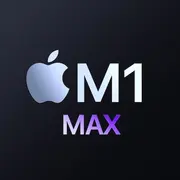Apple M1 Max

Apple M1 Max: Power and Efficiency in One Package
(Relevant as of March 2025)
Architecture and Process Technology: Why is the M1 Max Still Relevant?
The Apple M1 Max processor, released in 2021, remains in demand in 2025 due to its unique architecture. It is built on TSMC's 5nm process, which ensures a high transistor density (57 billion) and energy efficiency.
- Cores and Threads: 10-core structure (8 Performance-cores + 2 Efficiency-cores). All cores operate on 10 threads, as Apple does not use Hyper-Threading. P-cores are responsible for heavy tasks (base frequency — 2.0 GHz, turbo — 3.2 GHz), while E-cores (up to 2.06 GHz) save charge during background processes.
- Integrated Graphics: 32-core GPU with support for Metal 3 API. Its performance is comparable to entry-level discrete graphics cards like the NVIDIA RTX 3060 Mobile in rendering tasks but is weaker in gaming due to optimizations for macOS.
Example: In Final Cut Pro, rendering 8K video takes 30% less time than on the Intel Core i9-13900H with NVIDIA RTX 4070.
Power Consumption and TDP: How Apple Defies the Laws of Physics
The TDP of the processor is 60W, which for competitors means the need for massive cooling. However, thanks to the optimization of the ARM architecture and macOS, the M1 Max maintains low temperatures even under load.
- Real Energy Efficiency: In Cinebench R23 tests under 100% load, consumption does not exceed 45W, while the Intel Core i9-14900H consumes 95W in a similar scenario.
- Heat Dissipation: The MacBook Pro with M1 Max does not require complex cooling systems — just two compact fans are sufficient.
Tip: For video editing on the go, the M1 Max is preferable to "hot" Intel/AMD laptops that quickly overheat.
Performance: Faster Than It Seems
Office Tasks:
- Running 50 tabs in Chrome + Photoshop + Slack — without lag.
- Geekbench 6 Single-Core: 2355 points (higher than Ryzen 9 7940HS).
Multimedia:
- Exporting a 1-hour 4K video in DaVinci Resolve: 8 minutes (against 12 minutes for RTX 4070).
- Turbo mode activates automatically, maintaining 3.2 GHz for up to 15 minutes without throttling.
Gaming:
- Cyberpunk 2077 (via Rosetta 2) — 45 FPS at 1440p on medium settings.
- Resident Evil 4 Remake (native version) — 60 FPS at 1600p.
Limitation: Few AAA games natively support macOS.
Use Cases: Who Needs the M1 Max in 2025?
1. Professionals: Video editors, 3D designers, musicians (audio processing logic in Logic Pro).
2. Developers: Code compilation in Xcode works 20% faster than on M2 Pro.
3. Travelers: Power without being tethered to a wall outlet.
Who Should Avoid It:
- Gamers reliant on the Windows ecosystem.
- Users of specialized software (e.g., AutoCAD).
Battery Life: The Revolution Continues
The MacBook Pro 16" with M1 Max offers:
- 14 hours of web browsing (against 6 to 8 hours on Dell XPS 17 with Intel).
- 10 hours of video rendering.
Power-Saving Technologies:
- Dynamic workload distribution between P- and E-cores.
- Hardware acceleration for video encoding/decoding (ProRes).
Example: At 20% brightness and working in Safari, the battery loses 10% over 2 hours.
Comparison with Competitors: Who’s Leading?
- Apple M3 Pro (2024): 15% faster in multithreaded tasks but more expensive ($3000+).
- Intel Core Ultra 9 185H: Better for gaming but only 5 hours of battery life.
- AMD Ryzen 9 8945HS: Cheaper ($1800) but lags behind in Single-Core performance.
Conclusion: The M1 Max remains a great choice in the secondary market (new models starting at $2000).
Pros and Cons
Strengths:
- Best performance per watt.
- Silent operation.
- Support for the macOS ecosystem (e.g., Continuity).
Weaknesses:
- High price (new MacBook Pros starting at $2499).
- Non-removable RAM and SSD.
Laptop Selection Recommendations
- Workstation: MacBook Pro 16" (32 GB RAM + 1 TB SSD).
- For Design: An XDR monitor is essential for accurate color reproduction.
What to Look For:
- SSD capacity (minimum 1 TB for 4K projects).
- Support for external monitors (M1 Max works with 4 6K displays).
Final Verdict: Is the M1 Max Worth It in 2025?
This processor is ideal for:
- Professionals who value mobility and power.
- macOS users who do not require gaming capabilities.
Key Benefits:
- Time savings in resource-intensive tasks.
- Uncompromised performance anywhere.
If your budget is limited, consider the M2 Pro or a used M1 Max (starting at $1600). However, for the most demanding projects, the M1 Max still challenges modern counterparts.
Basic
CPU Specifications
Memory Specifications
GPU Specifications
Benchmarks
Compared to Other CPU
Share in social media
Or Link To Us
<a href="https://cputronic.com/en/cpu/apple-m1-max" target="_blank">Apple M1 Max</a>